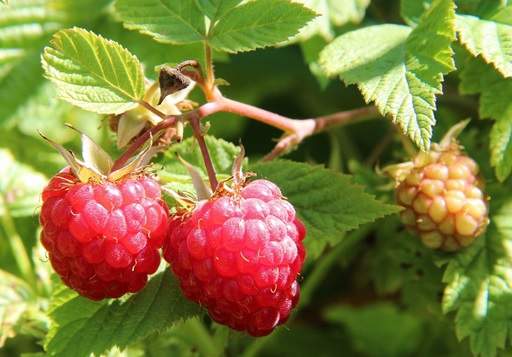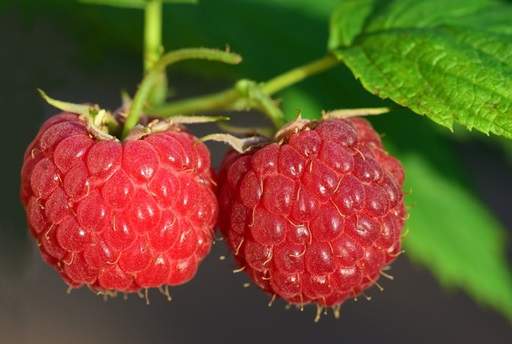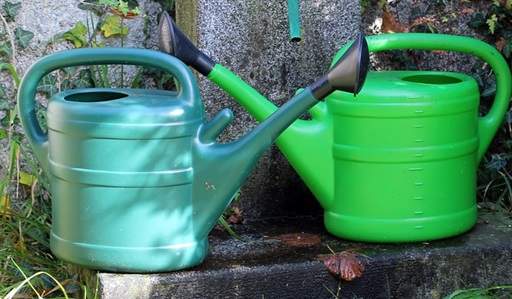How to Grow Your Own Raspberries
Raspberries are popular, vigorous, self-fertile cane plants which produce an abundance of delicious fruit. They are also easy to grow, making them a perfect beginner fruit, and suitable for gardens of any size or containers. There are two types of raspberry plants: summer-fruiting and autumn-fruiting. Summer-fruiting raspberries will be ready for harvesting in early summer, whilst autumn-fruiting raspberries are ready for picking between August and October. Raspberry Glen Moy is the earliest of the summer-fruiting raspberries. Raspberries are good for gardens in cooler northern climates as they flower late in the spring when there is little danger of them being damaged by late frosts.
Most varieties bear red fruit, but some are yellow, black or purple. All are deciduous. In general, red raspberry plants are stronger, hardier and more productive than their black, yellow and purple counterparts. Raspberries grow at chest height, making them easier to pick than strawberries. This also means you don't need to worry about protecting them from lying on the ground or from slugs. Raspberries are one of the most expensive fruits you can buy in the supermarkets and whilst they often look nice, the taste is frequently a let-down. By growing your own you can not only save money but also yield deliciously tasting fruits for yourself, friends and neighbours, especially given that the same plant can produce a reliable crop for over 20 years.

Raspberries - easier to grow than you might think
Primocanes vs. Floricanes
The difference between primocanes and floricanes is straightforward. Primocane varieties produce flowers and fruit on stems grown in the same year, whilst floricanes fruit on canes that developed the previous year. Summer fruiting varieties are floricanes and most autumn fruiting raspberries are primocanes. Different pruning techniques are required for each, given that they produce crops on different aged stems. Summer fruiting raspberries need to be tied into a support, whilst autumn-fruiting varieties are self-supporting, making them more suitable for container growing. Autumn-fruiting raspberries typically deliver a heavier crop than their summer-fruiting counterparts, which has earned them the name 'ever bearing' raspberries.

Raspberry Canes
Fruit
Raspberry crops tend to be very prolific, so there are usually enough to eat fresh with cream as well as make jam, jellies, syrups, liqueur, raspberry ripple ice cream and decorate cakes and other puddings. Raspberries offer endless dessert possibilities - they make a tasty topping to ice cream, can be mashed up and layered on cakes, used to flavour pancakes and waffles or made into a sauce. The fruits can also be spread over a salad to give it a special zing, made into juice and mixed with lemonade to create a refreshing drink or used to make raspberry vinegar. Raspberries will freeze well if you end up with too many; thawed frozen raspberries are great for providing a taste of summer on a cold, dark winter day. Summer-fruiting raspberries follow on straight after the strawberry season so there is no excuse not to get your five a day! Raspberries are loaded with vitamins, minerals and anti-oxidants, particularly vitamins A, C and E.

Recommended Raspberry Varieties
The best raspberry varieties are:
- Raspberry Autumn Bliss - heavy-cropping, autumn-fruiting deciduous raspberry producing large, fine-flavoured berries on the upper part of the current season's canes from July through to autumn. Autumn Bliss has a number of highly desirable characteristics: fruit in the first year of growth; strong disease resistance; and minimal support and pruning requirements, making it ideal for growing in containers.
- Raspberry Glen Lyon - self-fertile, floricane, thornless raspberry producing strong yields of large, glossy fruit that's consistently fine-flavoured and ready for picking in early June. Glen Lyon is a relatively new variety that's great for a range of culinary uses including desserts and suitable for freezing.Widely grown across Europe, it was originally developed in Scotland and now most common in Spain.
- Raspberry Malling Jewel - an excellent deciduous raspberry with short, slightly thorny canes and large, red fruit that has an excellent flavour in autumn. Malling Jewel is an all-purpose variety that's been popular for many years, cropping reliably but steadily each year. Compact growth habit with reasonable but not prolific yields; we'd recommend growing two plants beside one another to ensure you have a plentiful supply of fruit. Disease resistant.

- Raspberry Glen Moy - deciduous floricane raspberry producing large, conical fruits with a downy skin and exquisite taste. Glen Moy has the advantage of having non-spiny branches, making it easier to handle. The canes that have fruited should be cut back to ground level as soon as all the fruit has been picked. Winner of the RHS Award of Garden Merit, it gives good yields but the picking season is quite short. Disease resistant.
- Raspberry Malling Promise - deciduous shrub with large, long red berries with a firm texture and exquisite flavour that are ripe and ready for picking from early summer. Providing it's protected from strong winds, it produces reasonably high yieldsconsistently year after year. Malling Promise is our recommendation if you're restricted to just one variety.

Planting Advice
Whether you choose a primocane or floricane raspberry, the planting advice is largely the same.
When to Plant
Containerised raspberries can be planted at any time of the year, although some time during the dormant season between November and March when the soil is not waterlogged or frozen is best. Bare root raspberries must be planted during the dormant season.
Soil
Choose a site with a moist yet well-drained, fertile, slightly acidic to neutral soil. If you have a strongly acidic soil, add some lime to lower the pH to around 6. Avoid chalky soils or those that 'puddle' on the surface as this will make your plants vulnerable to root rot. If your ground often lies wet, consider planting raspberries in containers instead as raspberries are prone to root rot in waterlogged soil. It is important not to establish a raspberry patch in an area where you have recently grown tomatoes, peppers, or potatoes, to avoid verticillium wilt, which these vegetables can carry, and raspberries can catch.

Aspect & Exposure
Raspberries are tolerant of partial shade, but a sunny spot is preferred. It is advisable to avoid windy sites for two important reasons. Firstly, self-fertile raspberry flowers require insects to pollinate them from other flowers on the same plant and bees and other insects will struggle to do this if the site is excessively windy. Secondly, the fruiting side branches of some raspberry varieties can get quite long and are liable to break in strong winds, especially under the weight of the fruit.

Spacing
Once you've selected a site and purchased your raspberry plants, space them 45-60cm (1.5 to 2 feet) apart when planting. If you're growing multiple rows of raspberries or growing your raspberries near other plants in the kitchen garden, space the rows 1.8m (6 feet) apart, ideally running north to south so they do not shade each other. Give autumn-fruiting raspberries the full 60cm apart if the size of your garden permits. Plant far from wild growing berries to avoid the risk of pests and diseases on the wild plants spreading to your precious raspberry plants.
Planting
Dig at least a bucketful of well-rotted organic matter per plant into the ground when planting and back-fill firmly so as not to leave any air pockets. Mulch with a generous layer of bulky organic matter such as garden compost, old autumn leaves, straw or well-rotted manure avoiding overly rich manure which may burn the new shoots.

Container Growing
If planting raspberries in containers, pot them up in 30cm (12 inch) pots using a mix of 50% potting compost (John Innes No 3 is perfect) and 50% multi-purpose compost. An alternative is to plant a few raspberry plants around the edge of larger 60cm (24 inch) containers, if you intend to grow more than one raspberry bush and want them all in the same pot. Just be wary of overcrowding!

Watering, Feeding, Support and Initial Pruning
Feed with a slow-release multi-purpose feed and water well after planting. For summer-fruiting raspberries in containers, insert a training support such as a thick bamboo cane or pole to tie in your raspberry canes and train them up (this is also an option for autumn-fruiting varieties that don't support themselves as strongly). For all raspberries, whether summer or autumn-fruiting and ground or container grown, prune the canes to within 25cm (10 inches) of the ground after planting. This will encourage lots of basal shoots to be produced.

Training
Autumn Fruiting Varieties
Autumn-fruiting raspberries do not normally need to be tied in as they are shorter than summer-fruiting varieties and more self-supporting. However, if your garden is in a windy or exposed location, or if the planting site is shaded on one side (which will cause the raspberry canes to lean away from the source of shade in the direction of the sun), support as described below may be best for autumn-flowering raspberries too.
Summer Fruiting Varieties
Summer-fruiting raspberries can grow quite tall so need to be tied into a support structure. If you have a smaller garden and have limited space for your new raspberry canes, they're best either grown in containers or trained up a single fence post (you can space up to 3 plants around a single post). In larger gardens, a trellis or fence can work well, but the traditional method is to fix 2 posts 40-50cm (15-20 inches) apart at one end of the row and two more at the other end of the row, with wires fixed firmly between the 2 long sides to support the canes on both sides and stop them blowing over (set three horizontal wires at 50-60cm intervals from the ground). An alternative in sheltered areas is to stretch wires between single fence posts at the end of each row. Your raspberry canes should then be tied into the wires using string or soft twine. This will help your summer-flowering raspberries when they become top heavy when laden with fruit.
Top Tips:
(1) Keep fruiting canes on one side of the wire and young new canes on the other side of the wire to make it easier to distinguish fruited canes and young canes when pruning.
(2) If the wires gets stretched from the weight of the fruit, tighten them in early spring when pruning.

Raspberries grown with a traditional wire support system
Pruning
Summer-fruiting floricanes and autumn-fruiting primocanes produce their crop on different aged stems, so will require different pruning techniques. Annual pruning will result in healthier plants and better harvests but be sure to wear gardening gloves to protect against the thorns.
Autumn Fruiting Raspberries
The easiest to prune. Simply cut back all canes to ground level in February before the new growing season starts. Eliminate some canes during the summer only if canes are overcrowded. Raspberries spread by underground suckers and become very vigorous once established, so some summer thinning will inevitably be required for more mature plants. Remove weaker canes, those that grow side-ways and suckers that pop up more than 45cm from your wire/pole support first.

Prune all canes of autumn fruiting raspberries back to ground level in February
Summer Fruiting Raspberries
Summer fruiting raspberries are floricanes, so fruit on one year old canes. Cut fruited canes only right back to ground level once all fruit has been picked in autumn (don't cut all canes back to ground level as you'll want to keep some of the current year's new canes to produce fruit next year). Next, select the 8 thickest, strongest canes that developed in the current year (and will fruit next year) and tie them in along your support wires. The chosen canes should be spaced out 10cm (4 inches) apart on their support to allow as much light and air as possible. Finally, remove any remaining young stems to ground level.

Strongest canes of summer fruiting raspberries tied into their support
You may find it helpful to mark fruiting canes during the summer when they will be lush, green and easily distinguishable from last year's canes, to make the job of distinguishing them easier in autumn. An alternative approach is to keep all new canes on the opposite side of the horizontal wire supports to the older canes, so you can easily tell which to cut back to ground level in autumn. Even if you forget to do either of these, it should still be possible to distinguish last years growth from this year's growth as the former will be woodier and less flexible.
Harvesting
As the fruits begin to form, it's a good idea to cover your plants with some netting to prevent birds from stealing the crop (unless you choose to plant in a fruit cage). The berries of summer-fruiting varieties will ripen over about 2 weeks, so you'll need to pick the fruit every couple of days to get berries when they're just right. Pick berries on a sunny, dry day by grasping each berry carefully with thumb and forefinger and pulling gently.
If raspberries don't separate from the plant easily, without squashing the fruit, they're not ready for picking. Handle the fruit gently. Raspberries will only keep for around 5 days in the fridge once harvested, so if you have more than you can consume or cook with over this time, place the excess on a baking tray in the freezer. When frozen, raspberries can be moved into airtight bags and stored for 6 months. They will have all the uses of fresh berries when thawed.

If you grow both summer and autumn-fruiting raspberries, you will be guaranteed an almost continuous supply of fruit from July to October. However, if you do plant a mix of summer and autumn fruiting varieties, ensure they are planted sufficiently far apart to make sure they don't get mixed up when 'suckers' start to spring up; if you get confused which is which, it becomes very difficult to know what to prune when.
Pests & Diseases
Raspberries are usually very straightforward, pest and disease free and give a very worthwhile crop. Issues only typically arise if plants are grown too close together, causing over-crowding. Raspberry cane blight is a fungal disease which causes the leaves of fruiting canes to wither and the canes to become brittle, perhaps turning brown towards the base. Raspberry spur blight is another fungal disease causing dark chocolate-coloured patches on canes, whilst raspberry cane spot is represented by small purple spots on canes forming from May to June. All of these potential issues can be avoided by keeping your plants strong through regular watering, feeding and mulching. If they strike your plants, cut out the worst affected canes to below ground level as early as possible, tackle the remainder with a fungus killer spray, thin out remaining canes to improve air circulation if required and start feeding your raspberries more frequently. Root rot will only occur if the planting location is poor (e.g. soggy clay rather than well-drained), but results in sudden death of the plant right after flowering, when the weather turns warm. Powdery mildew is also easily avoided by ensuring fallen fruits and leaves are cleaned up in the autumn.

Fungal diseases on raspberry canes can be addressed with a fungus killer spray
Garden Care
With a little care, your raspberry plants should last for many years, producing delicious crops each summer or autumn. Raspberries have fairly shallow roots, so it's important to keep them well watered, particularly during the summer months and for container-grown plants. You can also help to retain moisture in the soil and prevent weed growth by spreading a thick mulch of well rotted manure or garden compost around the base of the plants whilst the ground is still moist in spring. To guarantee a maximum crop, apply a generous sprinkle of a slow release multi-purpose fertiliser or fish, blood and bone around the base of your raspberry plants in mid-spring. Particularly important for container grown raspberries but also helpful for those grown in the ground is to apply a monthly feed of general purpose liquid fertiliser during the growing season. Raspberry plants need a significant amount of nitrogen to grow to their full 1.8-2.1m (6-7 feet), but you should stop putting high-nitrogen fertiliser on them as fruiting time approaches. At this time, the plants must concentrate on producing fruit instead of leaves. Tie canes onto your horizontal support wires if using a wire support system and ensure that any 'suckers' that pop up more than 45cm from the support are removed. Collecting up and disposing of fallen autumn leaves will also improve hygiene and reduce the chance of disease.

Raspberries are shallow-rooted, so regular watering is important
Share this page:

